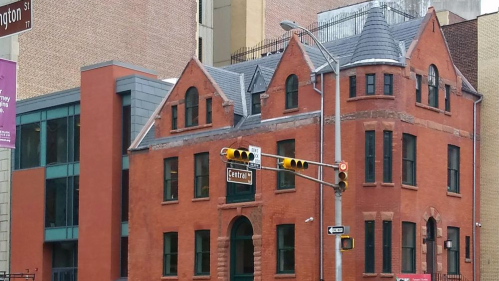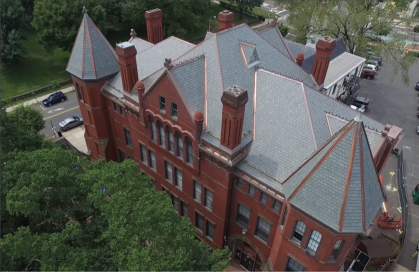Rutgers Recognized for Historic Preservation Efforts

The New Jersey Historic Preservation Office recently honored three Rutgers projects
Rutgers recently received three New Jersey Historic Preservation Awards, including recognition for a project to preserve remains at the site of the former Halsey Street Methodist Episcopal Cemetery – the current location of the Honors Living-Learning Community at Rutgers University-Newark.
The award-winning projects, managed by Rutgers Institutional Planning and Operations (IP&O), also include the Alumni Center at Rutgers-Newark and the New Jersey Hall roof restoration. The honor, by the New Jersey Department of Environmental Protection Historic Preservation Office, recognizes work that contributes significantly to advancing the field of historic preservation and produces livable communities in New Jersey.

The team that worked on the Honors Living-Learning Community, led by Trenton-based Hunter Research, is being recognized for its archeological resource management. Initial research on the project site indicated that the Halsey Street Methodist Episcopal Cemetery and its affiliated church once occupied the area, said Thomas Boland, IP&O’s director of project services.
“We did our due diligence and hired an archeological firm to investigate what might be underground, which would inform the proper course of action,” Boland said. “During the first phase of the archeological survey, the team identified human remains.”
This was followed by phase 2 and 3 archaeological efforts. In all, the multi-phase archeological investigation took two years to complete and yielded over 300 sets of human remains and 52 boxes of artifacts.
“The church and cemetery were there in the mid-1800s, and they stopped using the site in 1890. In 1920, some of the bodies from the cemetery were exhumed and moved to another cemetery in accordance with the standards of the time,” he said.
Rutgers purchased the property in the 1950s. At that time, it was being used as a parking lot.
The complex dig resulted in a two-volume, 700-page report along with digital photos and detailed burial recordation sheets. The artifacts from the cemetery and adjoining homes numbered over 20,000. All of the remains were taken to Hollywood Cemetery in Union and re-interred there.
“The artifacts were from the cemetery and the privies that existed behind the houses that once stood there. We uncovered china and silverware, and a total of 52 boxes of artifacts,” Boland said.
Privies, or out-houses, were also used to dump trash in days before trash hauling became the norm. They are often a source of interesting finds during digs, Boland said.
With a Rutgers-owned 391 bed dormitory and parking garage on the site, there are no concerns that remains still lie below the building, said Dave Schulz, vice president and university architect.
“The project team explored every direction and beyond the boundaries of the church and cemetery. Extraordinary steps were taken not only to ensure that all remains were found and removed, but to treat the remains with appropriate dignity and respect,” Schulz said. “We see this award recognizing the complexity of the project and the high level of stewardship and respect for human remains.”
IP&O was also recognized for its historic preservation work on the Alumni Center at Rutgers-Newark, located in Newark’s James Street Commons Historic District at 72 Washington Street. Rutgers alumna Meredith Arms Bzdak (GSNB’87,’95) oversaw the research and preservation of the stately former home for Princeton-based Mills + Schnoering Architects, the project designer. The Queen Anne style building was built around 1885 by Newark architect William Halsey Wood as a residence and office for Joseph Fewsmith, a prominent Newark doctor.
“At some time in the 1940s, the building changed hands, and over the years, became run down,” Boland said. Rutgers purchased it and did an extensive renovation, restoration and addition.
“The marble floors and original spiral staircase were restored, and the addition to the building makes it accessible to anyone with mobility issues,” said Boland.
Prior to this, the Rutgers-Newark advancement team, which includes alumni relations, was housed in three different buildings on the Newark campus. This building allowed for consolidation while preserving another part of Newark’s history.
“Rutgers can be proud of our contributions to the City of Newark, while at the same time expanding opportunities for local disenfranchised students and our diverse and world-renowned Newark alumni,” said Nicholas Fabbroni, assistant vice president of University Facilities Project Services.
On the Rutgers-New Brunswick campus, the New Jersey Hall roof restoration restored much of the historic building’s roofing and metalwork including gutters, cornices, shingles and slate. The hall, located on the College Avenue Campus, was constructed in 1889 and served as the former home of the New Jersey Agricultural Experiment Station. It was added to the National Register of Historic Places in 1975. IP&O employees Susan Ryan, Sean Roche and Chris Hack oversaw the renovations.
“We are committed to preserving our history, and our staff takes great pride in the work that they do to contribute to that preservation across our campuses,’’ said Antonio M. Calcado, executive vice president and chief operating officer. “These awards are reflective of the good work they do.’’


